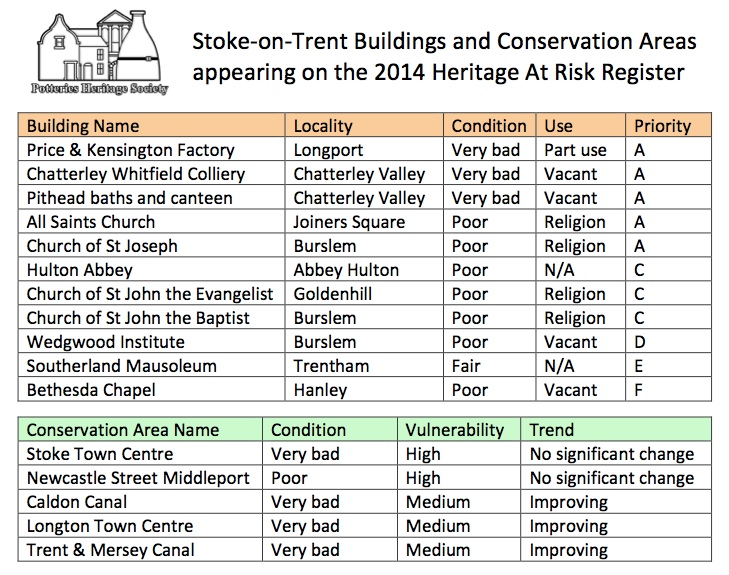11 listed buildings and 5 conservation areas in Stoke-on-Trent remain on the national Heritage At Risk register, revised for 2014 by English Heritage. The full details are available on their website here but we have included a summary below, which places them in order of priority or vulnerability.
The inclusion of most of the buildings listed will not be a surprise to our members as many are vacant or underused properties that the Society has raised concerns over for many years. It is also no coincidence that those in the highest priority category are underused industrial sites. Churches occupy almost half the buildings list and include Bethesda Chapel, the ongoing restoration of which our members have actively supported, and St Joseph's in Burslem which featured in our recent Stained Glass in The Potteries event. The Wedgwood Institute remains on the list due to its poor condition but has moved to a lower priority (D from C) because of the interest shown by the Prince's Charities.
The list also includes some of the City's vulnerable conservation areas. These include the two canal corridors that together cover the 14 miles of canal which pass through our boundary. Fortunately these are viewed as 'improving', perhaps through the work of the Canal & Rivers Trust, new canalside developments and heritage investment such as that in Middleport Pottery. Longton Town Centre is also improving and has recently benefited from the Buildings Improvement Scheme which has achieved so much in Burslem.

Also of concern are the conservation areas for Stoke Town Centre, where the uncertain future of the Spode site is having an impact, and that centred on Newcastle Street in Middleport, where concerns have been voiced about the clearance of terraced houses and the impact of new development.
However, these short lists mask a greater problem for the City. English Heritage admits that they do not have enough information on Grade II listed buildings (which comprise the majority of listings both in the City and nationally) and the register does not recognise buildings of heritage or local value that are not listed. Many threatened structures, such as bottle ovens, are part of larger complexes that are generally in better condition.
The register also looks at the building's current condition and circumstances, whereas we know that many more buildings in the City have an uncertain future as austerity bites and numerous properties are being sold off.
So, although the Heritage At Risk register gives a useful indication of the main battlefronts, it only hints at the sheer expanse of the heritage in danger in Stoke-on-Trent.
